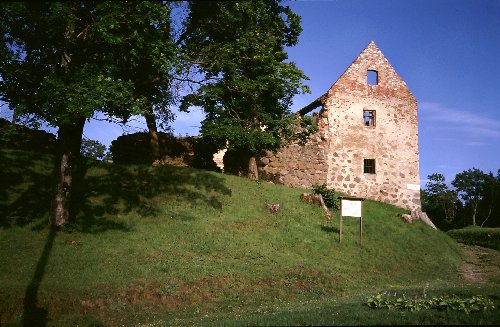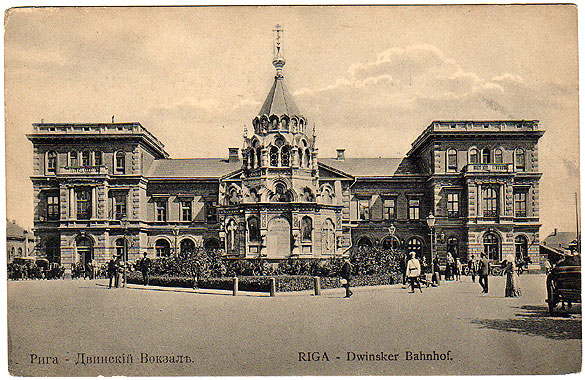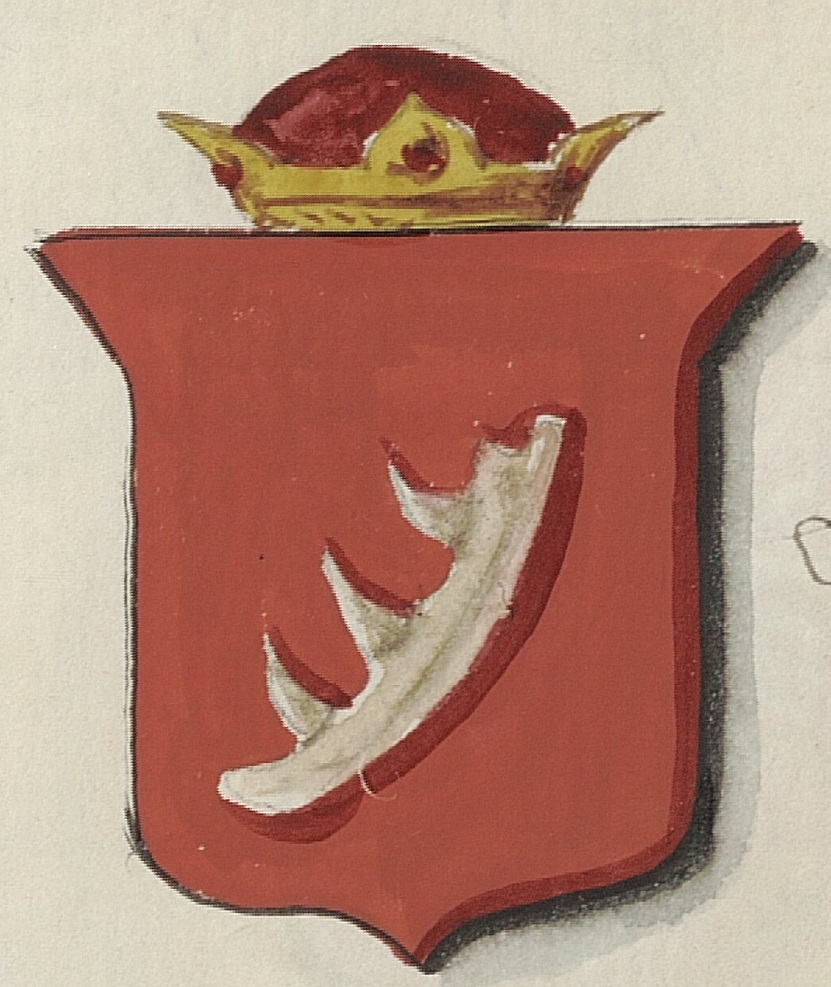|
Krustpils Castle
Krustpils Castle (German: ''Kreutzburg'', Polish: ''Krzyżbork'') is a castle in Jēkabpils, Latvia. It is one of the best preserved medieval castles in Latvia. During the Russo-Turkish War (1877–1878), Turkish prisoners of war were held here, many of whom later settled here permanently. Here the Latgale artillery regiment was located. During the Second World War infirmary of the German army was located here. A military hospital of the Red Army was placed here after August 1944. History The first written reference of the Krustpils dates from 1237, when the Archbishop of Riga built a castle named Kreutz. In 1359, the Livonian order took seven castles belonging to the Riga Archbishopric, being Krustpils among them. During the Livonian war in 1559 the castle was devastated. When the Livonian state was dissolved, Krustpils became property of the Polish–Lithuanian Commonwealth from 1561 to 1772, while the opposite Jēkabpils was part of the Duchy of Courland and Zemgale. The ... [...More Info...] [...Related Items...] OR: [Wikipedia] [Google] [Baidu] |
Jēkabpils
Jēkabpils (; german: Jakobstadt; pl, Jakubów) is a state city in Jēkabpils Municipality in southeastern Latvia roughly halfway between Riga and Daugavpils and spanning the Daugava River. Historic Jēkabpils lies on the left bank, in Selonia while historic Krustpils (german: Kreutzburg, links=no) lies on the right bank, in Latgale. The two cities were united during Soviet rule in 1962 under the Jēkabpils name, but retain their distinct regional character. Jēkabpils was also formerly home to former Soviet Jēkabpils Air Base. History A stone cross-castle – Cruczeborch (german: Kreutzburg) – was built in 1237 by the bishop of Rīga. Archeological excavations on the nearby Asote mound indicate that this place was a busy trading centre for the Latgalians, one of the Latvian tribes, and had been inhabited since 1000 BC. An adjoining settlement already existed when Krustpils Castle was first built; it grew up around the castle as the village of Krustpils. The village ... [...More Info...] [...Related Items...] OR: [Wikipedia] [Google] [Baidu] |
Zemgale
Semigallia, also spelt Semigalia, ( lv, Zemgale; german: Semgallen; lt, Žiemgala; pl, Semigalia; liv, Zemgāl) is one of the Historical Latvian Lands located in the south of the Daugava river and the north of the Saule region of Samogitia. The territory split between Latvia and Lithuania, previously inhabited by the Semigallian Baltic tribe. They are noted for their long resistance (1219–1290) against the German crusaders and Teutonic Knights during the Northern Crusades. Semigallians had close linguistic and cultural ties with Samogitians. Name The name of Semigallia appears in sources such as ''Seimgala'', ''Zimgola'' and ''Sem'' 'e'''gallen''. The -gal element means "border" or "end", while the first syllable corresponds to ''ziem'' ("north"). So the Semigallians were the "people of the northern borderlands" i.e. the lower parts of the Mūša and Lielupe river valleys. Territory 1st - 4th centuries Between the 1st and the 4th century the cultural area of Semigallia ... [...More Info...] [...Related Items...] OR: [Wikipedia] [Google] [Baidu] |
List Of Castles In Latvia
This is the List of castles in Latvia, which includes fortified residences of Western European conquerors built in the area of present-day Latvia before the 17th century. There are about 140 medieval castles in the area, therefore this list is not complete. After the name of the castle comes the year of construction and a short description of its present-day condition. Table of contents Courland Zemgale Vidzeme Latgale See also *List of castles *List of castles in Estonia *List of palaces and manor houses in Estonia *List of palaces and manor houses in Latvia * List of hillforts in Latvia *List of castles in Lithuania Additional information References Sources * * External links Ambermarks - Medieval castles of Latvia - list {{List of castles in Europe * Latvia Cas Lists of castles by country Castles A castle is a type of fortified structure built during the Middle Ages predominantly by the nobility or royalty and by military orders. Scholars debate the ... [...More Info...] [...Related Items...] OR: [Wikipedia] [Google] [Baidu] |
Ruins
Ruins () are the remains of a civilization's architecture. The term refers to formerly intact structures that have fallen into a state of partial or total disrepair over time due to a variety of factors, such as lack of maintenance, deliberate destruction by humans, or uncontrollable destruction by natural phenomena. The most common root causes that yield ruins in their wake are natural disasters, armed conflict, and population decline, with many structures becoming progressively derelict over time due to long-term weathering and scavenging. There are famous ruins all over the world, with notable sites originating from ancient China, the Indus Valley and other regions of ancient India, ancient Iran, ancient Israel and Judea, ancient Iraq, ancient Greece, ancient Egypt, Roman sites throughout the Mediterranean Basin, and Incan and Mayan sites in the Americas. Ruins are of great importance to historians, archaeologists and anthropologists, whether they were once individual f ... [...More Info...] [...Related Items...] OR: [Wikipedia] [Google] [Baidu] |
Jēkabpils Air Base
Jēkabpils , also known as Krustpils, is an air base located northeast of Jēkabpils, a town in Latvia. During the 1980s it was one of 17 airfields hosting the Soviet Union's tactical reconnaissance aircraft regiments.STATUS OF SOVIET TACTICAL RECONNAISSANCE FORCES USSR/EASTERN EUROPE/AFGHANISTAN(SANITIZED) March 22, 1984, CIA-RDP84T00491R000101240001-9, Central Intelligence Agency, Washington, DC. History Its exact founding date is unknown. Until the occupation of Latvia, the airfield functioned as the Krustpils airfield of the Latvian Aviation Regiment. Around 19 ...[...More Info...] [...Related Items...] OR: [Wikipedia] [Google] [Baidu] |
Soviet Times
The history of Soviet Russia and the Soviet Union (USSR) reflects a period of change for both Russia and the world. Though the terms "Soviet Russia" and "Soviet Union" often are synonymous in everyday speech (either acknowledging the dominance of Russia over the Soviet Union or referring to Russia during the era of the Soviet Union), when referring to the foundations of the Soviet Union, "Soviet Russia" often specifically refers to brief period between the October Revolution of 1917 and the creation of the Soviet Union in 1922. Before 1922, there were four independent Soviet Republics: the Russian Soviet Federative Socialist Republic, Ukrainian Soviet Socialist Republic, Byelorussian SSR, and Transcaucasian SFSR. These four became the first Union Republics of the Soviet Union, and was later joined by the Bukharan People's Soviet Republic and Khorezm People's Soviet Republic in 1924. During and immediately after World War II, various Soviet Republics annexed portions of countri ... [...More Info...] [...Related Items...] OR: [Wikipedia] [Google] [Baidu] |
Riga–Daugavpils Railway
The Riga–Daugavpils railway line ( lv, Dzelzceļa līnija Rīga—Daugavpils) is a long railway line in Latvia which connects the cities of Riga in central Latvia and Daugavpils in south-eastern Latvia. The railway line is double track between Riga and Krustpils and single track between Krustpils and Daugavpils. The track gauge is (Russian gauge). It was built in 1861, and is one the oldest railway lines in Latvia. History The railway line was opened on 21 September 1861 as one of the first railway lines in the present territory of Latvia. It was a part of the Riga–Oryol railway line, a long railway line in the Russian Empire, constructed to connect the Baltic Sea at Riga with Oryol in central Russia. At Daugavpils the line connected with the Saint Petersburg–Warsaw Railway Saint Petersburg–Warsaw Railway (() (transliteration: Sankt-Peterburgo–Varshavskaya zheleznaya doroga)) is a long railway, built in the 19th century by the Russian Empire to connect Russ ... [...More Info...] [...Related Items...] OR: [Wikipedia] [Google] [Baidu] |
Baroque
The Baroque (, ; ) is a style of architecture, music, dance, painting, sculpture, poetry, and other arts that flourished in Europe from the early 17th century until the 1750s. In the territories of the Spanish and Portuguese empires including the Iberian Peninsula it continued, together with new styles, until the first decade of the 19th century. It followed Renaissance art and Mannerism and preceded the Rococo (in the past often referred to as "late Baroque") and Neoclassical styles. It was encouraged by the Catholic Church as a means to counter the simplicity and austerity of Protestant architecture, art, and music, though Lutheran Baroque art developed in parts of Europe as well. The Baroque style used contrast, movement, exuberant detail, deep colour, grandeur, and surprise to achieve a sense of awe. The style began at the start of the 17th century in Rome, then spread rapidly to France, northern Italy, Spain, and Portugal, then to Austria, southern Germany, and Russia. B ... [...More Info...] [...Related Items...] OR: [Wikipedia] [Google] [Baidu] |
Latvian Land Reform Of 1920
The Latvian Land Reform of 1920 ( lv, 1920. gada agrārā reforma Latvijā) was a land reform act expropriating land under the Republic of Latvia in 1920 (during the Latvian War of Independence shortly after independence). The agrarian reform law of 1920 sought to transfer most of the land from Baltic German nobles to Latvian farmers. On September 16, 1920 Constitutional Assembly of Latvia passed the law of the Land reform, which would break up large landholdings and redistribute land to those peasants who worked it and to the newly created Latvian State Land Fund. Similar land reforms were carried out in Estonia (1919), Lithuania (March 29, 1922) and Poland (December 28, 1925). Background Before World War I some 2% of landowners owned 53% of land in Kurzeme and Vidzeme, in Latgale it was 38%. The Agrarian reform Law of September 16, 1920 created State Land Fund which took over 61% of all land. Objective The main objectives of the reform were several - the creation of new ... [...More Info...] [...Related Items...] OR: [Wikipedia] [Google] [Baidu] |
Stephen Báthory
Stephen Báthory ( hu, Báthory István; pl, Stefan Batory; ; 27 September 1533 – 12 December 1586) was Voivode of Transylvania (1571–1576), Prince of Transylvania (1576–1586), King of Poland and Grand Duke of Lithuania (1576–1586). The son of Stephen VIII Báthory and a member of the Hungarian Báthory noble family, Báthory was a ruler of Transylvania in the 1570s, defeating another challenger for that title, Gáspár Bekes. In 1576 Báthory became the husband of Queen Anna Jagiellon and the third elected king of Poland. He worked closely with chancellor Jan Zamoyski. The first years of his reign were focused on establishing power, defeating a fellow claimant to the throne, Maximilian II, Holy Roman Emperor, and quelling rebellions, most notably, the Danzig rebellion. He reigned only a decade, but is considered one of the most successful kings in Polish history, particularly in the realm of military history. His signal achievement was his victorious campaign i ... [...More Info...] [...Related Items...] OR: [Wikipedia] [Google] [Baidu] |
Daugava River
, be, Заходняя Дзвіна (), liv, Vēna, et, Väina, german: Düna , image = Fluss-lv-Düna.png , image_caption = The drainage basin of the Daugava , source1_location = Valdai Hills, Russia , mouth_location = Gulf of Riga, Baltic Sea , mouth_coordinates = , subdivision_type1 = Country , subdivision_name1 = Belarus, Latvia, Russia , length = , source1_elevation = , mouth_elevation = , discharge1_avg = , basin_size = , pushpin_map = , pushpin_map_size = , pushpin_map_caption = , pushpin_map_alt = The Daugava ( ltg, Daugova; german: Düna) or Western Dvina (russian: Западная Двина, translit=Západnaya Dviná; be, Заходняя Дзвіна; et, Väina; fi, Väinäjoki) is a large river rising in the Valdai Hills of Russia that flows through Belarus and Latvia into the Gulf of Riga of the Baltic Sea. It rises close to the source of the Volga. It is in length, of which are in Latvia and are in Russia. It is a westward-flowing river, t ... [...More Info...] [...Related Items...] OR: [Wikipedia] [Google] [Baidu] |
Selonia
Selonia ( lv, Sēlija; lt, Sėla), also known as Augšzeme (the "Highland"), is one of the Historical Latvian Lands encompassing the eastern part of the historical region of Semigallia ( lv, Zemgale) as well as a portion of northeastern Lithuania. Its main city and cultural center is Jēkabpils. The Selonian language has become extinct, though some of the inhabitants still speak a Latgalian dialect. History The territory of Selonia is defined by Latvian law as follows: the part of Aizkraukle city on the left bank of the Daugava, Daudzese Parish, Jaunjelgava Parish, Jaunjelgava city, Mazzalve Parish, Pilskalne Parish, Sece Parish, Sērene Parish, Staburags Parish, Sunākste Parish, Zalve Parish, Bebrene Parish, Demene Parish, Dviete Parish, Eglaine Parish, Ilūkste city, Kalkūne Parish, Laucesa Parish, Medumi Parish, Pilskalne Parish, Prode Parish, Saliena Parish, Skrudaliena Parish, Subate city, Svente Parish, Šēdere Parish, Tabore Parish, Vecsaliena Parish, the ... [...More Info...] [...Related Items...] OR: [Wikipedia] [Google] [Baidu] |
.jpg)






